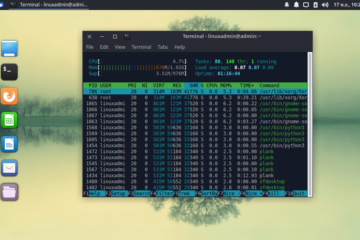Wireless Presentation – What Are The Options?
We have equipped some of our classrooms with fixed beamers and more will follow. From time to time the desire is expressed to see whether you can ‘simply’ transmit a picture / video or the whole screen wirelessly from your smartphone or private laptop. Up to now we have provided a VGA / HDMI cable for our own devices. This usually works quite well, but this excludes smartphones, for example. That’s why we have been investigating and testing solutions for wireless presentation to a projector and screen for some time now, and whether they really are better and more reliable than a wired solution.
Requirements
Our requirements are as follows:
- Support of all current operating systems (Windows, macOS, Linux, Android, iOS)
- Possibility to mirror the screen
- easy operability
- reliable in everyday school life
- “Hijacking”, i. e. the screens / projectors should not be taken over by third parties (e. g. students)
There are many HDMI wireless dongles that promise wireless presentation. In addition, there are the many different standards: Google’s Chromecast, Apples Airplay, Microsoft’s Wireless Display Adapter (Miracast). If only one operating system had to be supported, the selection would be quite large. I know schools that have equipped their classrooms with Apple TVs and give each colleague an iPad. This works quite well within this ecosystem, but we don’t have this budget 🙂 For this reason, there are very few options if you want to support Linux.
Chromecast
The Chromecast is HDMI stick, which supports a large number of devices, actually everything a Chrome / Chromium Browser runs on. You can easily transfer single tabs, the whole screen or content from certain apps (e.g. Youtube App) to the projector or a screen.
Advantages
- Price (approx. 40$)
- Support of all major operating systems
- Connection with Ethernet adapter possible
Disadvantages
- supports only WPA2 Personal, no WPA Enterprise
- no screen mirroring on some mobile platforms
- no management platform to manage many Chromecasts
Generally speaking, it can be said that the Chromecast is designed for home use and therefore lacks some of the features that might be useful in a school or university network.
Airtame
Airtame is another HDMI dongle that promises very easy handling and has been specially designed for schools, companies and universities. As far as I know, Fedora is running on the stick itself.
Advantages
- Support of all major operating systems
- Connection with Ethernet adapter possible
- real mirroring of the screen, no “casting”, i. e. Youtube videos are transferred by the computer in contrast to Chromecast, which downloads them from the Internet itself.
- supports all WLAN standards (also WPA Enterprise)
- Central platform to manage many Airtames
- Option to connect via PIN
Disadvantages
- Price (approx. 300€)
Conclusion
Chromecast and Airtame are two options for wireless presentation. Airtame is actually the device you want for a school, but it has its price. Chromecast, on the other hand, is much cheaper, but does not offer some features that would be “nice-to-have”. We are currently testing the Chromecast and seeing how good and reliable it is in everyday school life and “multi-user operation”. Especially the simplicity of operation has to be tested, e.g. how this differs on the individual platforms.
Which device do you use for wireless presentation?



5 Comments
Brijesh Patel · March 9, 2018 at 9:17 am
Hi,
I had a similar situation last year when we were exploring our option regarding wireless projection. Initially, Chromcast looked like a viable option, but because of the limitation of Chromcast (e.g. lack of WPA2 Enterprise, No sound on Linux if you are not using Chromium browser, No tool for managing them) and of course it is not opensource. So, we then thought of developing something in-house, and we did develop a tool, we called it MirrorCast. It has been in production for more than six months, and so far we are happy with that.
Following is the setup.
A Raspberry Pi (receiver/server) with speakers connected to the Projector via HDMI cable. A software called OMXPlayer ( part of XBMC built for Pi) runs on the server when required to mirror/cast. The client runs a small Python client called Mirrocast to connect to the Pi.
Currently supports the following features.
* Mirroring of the desktop
* A casting of Youtube videos (plays from the Pi, so the user can carry on working on his/her laptops also no issue of lagging)
* Freeze – User can freeze the screen very useful when you want to students to work on a particular slide while you carry on working on your laptop
* If a user connected to a projector, another person can’t use it.
* Reconnect to the server if for some reason it lost the connection, i.e. user didn’t initiate a disconnect
* Play media files or DVD from the laptop
Features we would like to add:
* Mirroring of a particular window or tab
* Support for Tablets and Smart Phones
* Better handling of Network Congestion
If you want to see how the client looks like please visit https://3djakedesigns.org/mirrorcastmenu.jpg
and the code is on the GitHub
https://github.com/ASHS-School/mirrorcast
Stephan · March 9, 2018 at 10:43 am
Thanks for your comment. I saw your post on reddit and really like your solution. The problem we have is, that we like to support as much OS’ as possible. Your solution looks like it’s Ubuntu only.
Do you know UV4L? Looks very promising, too. You can use the screen sharing API in Firefox/Chrome to mirror your screen or a specific windows. Freezing is also possible. https://www.linux-projects.org/uv4l/tutorials/screen-mirroring/
Brijesh Patel · March 12, 2018 at 12:55 am
I don’t know about UV4L, but I will check it out.
J. H · April 12, 2018 at 8:17 pm
Thank you for the information! I guess (or rather hope) that many schools will profit from a good open source solution to that problem. I am currently looking for a good use for my raspi II after replacing it with a model III. I guess I will give it a try with uv4l.
Stephan · April 12, 2018 at 8:31 pm
Good idea. That’s on my ToDo list, too, but I haven’t had the time yet. Looking forward to your experiences.